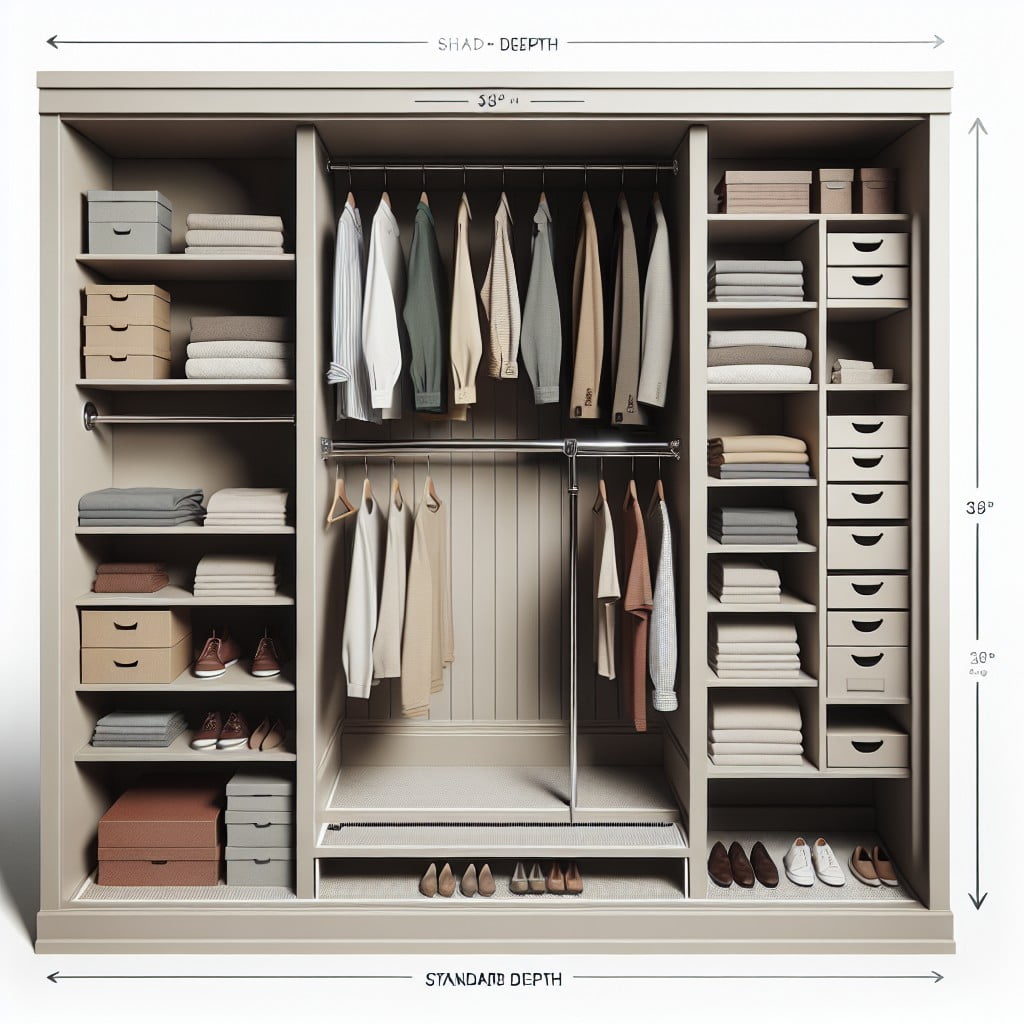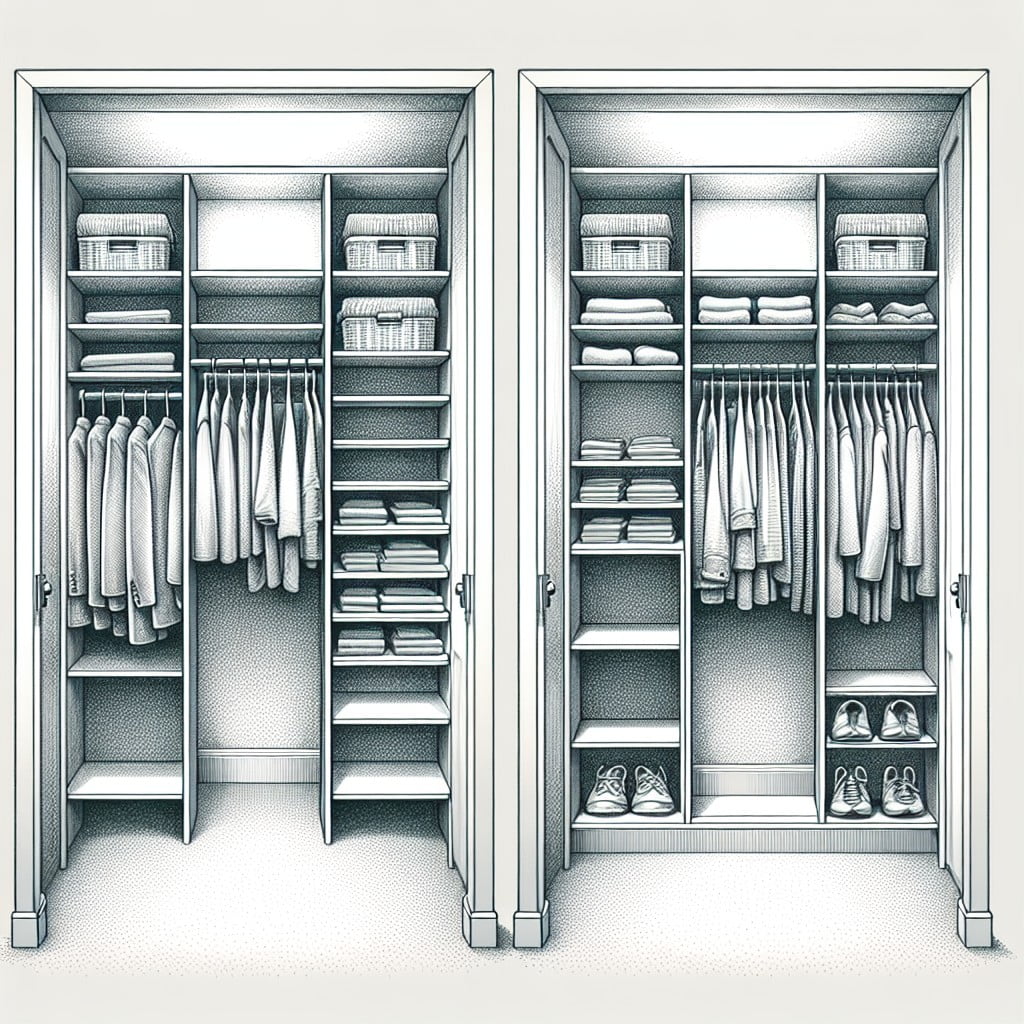Last updated on
Dive into the world of closet organization, scrutinizing standard closet depths for different types of closets because understanding their dimensions is key to maximizing storage while maintaining ease of access.
Designing a closet with the right depth can transform a cramped storage space into a functional wardrobe sanctuary. While the standard reach-in closet maintains a snug 24-inch depth to suit most garments, walk-in closet enthusiasts might aim for a more generous 36 to 40 inches for an airier arrangement.
Choosing the ideal shelf depth for shoes and the optimum drawer depth for your folded treasures is equally crucial. And of course, ensuring that your hanging rods offer enough clearance is key to keeping your clothes in pristine condition.
Dive into the details of crafting the perfectly proportioned closet that caters to all your storage needs, with clear guidance on dimensions that will maximize both space and style.
Key takeaways:
- Standard reach-in closet depth is typically 24 inches.
- Walk-in closets should have a depth of at least 36 to 40 inches.
- Shelves for shoes require 12 to 14 inches of depth.
- Drawers for folded items are best at 14 to 18 inches deep.
- Hanging rods need a depth of at least 22 to 24 inches.
Standard Closet Depth

The typical reach-in closet is designed with a depth of 24 inches. This allows most clothes on hangers, including shirts, blouses, and jackets, to fit comfortably without being crushed against the back wall.
However, for coats or garments with more bulk, a depth of 28 inches is preferable to prevent wrinkling and maintain air circulation. Additionally, allowing a few extra inches ensures that doors or closet systems close easily without snagging on fabric.
For closets with sliding doors, a 24-inch depth still applies, but if using bifold doors, consider the space needed for door clearance when planning your closet’s interior layout.
Standard Vs. Walk-In Closet

When distinguishing between a standard and a walk-in closet, space and layout are the key differences. A standard closet typically presents as a reach-in, where access is limited to the area of the closet opening. It often ranges from 24 to 30 inches in depth, allowing for the hanging of clothes without interference with doors or walls.
On the flip side, walk-in closets boast a more spacious design, permitting an individual to enter and move within the area. These closets generally start at 36 inches deep, providing ample room for a variety of storage solutions such as shelves, drawers, and multiple hanging areas. The distinction also lies in personalization: walk-in closets can be customized to a greater extent, catering to specific storage needs and preferences.
Walk-In Closet Depth
For a comfortable walk-in closet space, aim for a depth of at least 36 to 40 inches. This allows for adequate room to navigate between clothing items and the storage units.
When planning, consider the type of clothing and accessories to be stored. For example:
- Long garments, such as dresses and coats, require a clear space of at least 24 inches to hang without touching the back wall.
- Shelves for shoes typically need about 12 to 14 inches of depth.
- Drawers for folded items are best at 14 to 18 inches deep to accommodate a range of clothing sizes.
- Incorporate additional space for movement if an island or seating is desired in the center.
Remember, customization based on personal storage needs and the dimensions of the space ensures both functionality and comfort within a walk-in closet.
Closet Vs. Wardrobe
Understanding the distinction between closets and wardrobes is essential for optimizing bedroom storage.
Closets are built into the room, offering a concealed space with doors that align with the walls.
Wardrobes, in contrast, are freestanding pieces of furniture that can be moved and are not part of the room’s construction.
This means that while wardrobes can be placed in rooms with limited or no built-in closets, they also require additional floor space and can affect the room’s flow.
The choice between the two often comes down to space availability, personal preference, and whether the storage solution needs to be flexible or fixed.
Hanging Rods
In selecting the proper depth for your closet, consider the items you plan to hang. Most clothing, such as shirts, blouses, and jackets, require a rod depth of at least 22 to 24 inches to hang without wrinkling against the back wall. For coats or bulkier items, a few extra inches ensure they remain uncrushed.
Ensure adequate clearance in front of the rod as well; a 24-inch clear space allows for comfortable access and clothing removal. Rod height is also a factor—if double-hanging, allocate a minimum of 42 inches for the upper rod and 32 inches for the lower to prevent garments on the upper rod from touching those below.
FAQ
Can a closet be 16 inches deep?
Yes, a closet can be 16 inches deep, though the fit for hanging clothes may differ compared to deeper closets.
Can a closet be 17 inches deep?
No, a closet should not be 17 inches deep as it needs to be at least 24 inches deep to accommodate standard-sized hangers and allow clothing enough breathing space.
Can a closet be 20 inches deep?
Yes, a closet can be 20 inches deep, although the common depth of a modern closet typically ranges from 20 to 24 inches.
Is 18 deep enough for a closet?
Yes, an 18-inch depth is suitable for a closet, since the typical requirement for shelf depth ranges from 14 to 20 inches, accommodating double-hanging garments and seasonal clothing.
Is a 24-inch depth sufficient for walk-in closets?
No, a 24-inch depth is not sufficient for walk-in closets as it does not allow adequate space for hanging clothes.
What is the ideal depth for a linen closet?
The ideal depth for a linen closet ranges from 12 to 16 inches.
Can a 22-inch deep closet efficiently accommodate hangers?
Yes, a 22-inch deep closet can efficiently accommodate hangers as standard clothing hangers are approximately 17-18 inches in width.
Recap:




